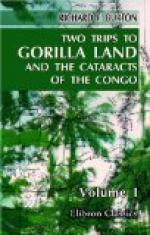On April 22nd, after some five weeks in the Gaboon River, I found myself once more in her Majesty’s steam-ship “Griffon,” which had returned from the south coast, bound for Corisco (Gorilla Island?) and Fernando Po. It was “going-away day,” when proverbially the world looks prettier than usual, and we enjoyed the suggestive view of the beaded line which, seen from the sea, represents the Sierra del Crystal. The distance from Le Plateau to the Isle of Lightning was only thirty-five miles, from the nearest continent ten, and before the evening tornado broke from the south-east, here the normal direction, we were lying in the roads about two miles from the landing-place. The anchorage is known by bringing Mbanya (Little Corisco), the smaller and southern outlier in a line between Laval Islet and the main island.
The frequent coruscations gave a name to Corisco, which the natives know as Mange: it was called, says Barbot, “’Ilha do Corisco,’ from the Portuguese, because of the violent horrid lightnings, and claps of thunder, the first discoverers there saw and heard there at the time of their discovery.” There is still something to be done in investigating the cause of these electrical discharges. Why should lofty Fernando Po and low-lying Corisco suffer so much, when Zanzibar Island, similarly situated, suffers so rarely? Again, why is Damascus generally free from thunder-storms when Brazilian Sao Paul, whose site is of the same altitude and otherwise so like, can hardly keep the lightning out of doors? The immunity of Zanzibar Island can hardly be explained by the popular theory; neither it nor Fernando Po, which suffers greatly from thunder-storms, lies near the embouchure of a great river, where salt and fresh water may disturb electrical equilibrium. I shall say more upon this point when in the Congo Regions (chap. xii.).
The position of Great Corisco (north latitude 0deg. 55’ 0”) is at the mouth of a well-wooded bay, which Barbot (iv. 9) calls Bay of Angra, i.e. Bight of Bight. He terms the southern or Munda stream Rio de Angrta, or Angex, whilst the equally important Muni (Danger) becomes only “a little river” without name. The modern charts prefer Corisco Bay. It measures some forty miles from north to south by half that depth, and its position causes the rains, which are synchronous with those of the Gaboon, to be much more copious and continuous. They last nine months out of twelve, and in March, 1862, the fall was 25 inches, the heaviest remembered it had filled the little island valleys, and made the paths lines of canal.
Next morning we were visited by the Rev. Mr. Mackey, the senior of the eight white men who inhabit this piece of land—a proper site for Robinson Crusoe—where, as the Yankee said of Great Britain, you can hardly stretch yourself without fear of falling overboard. He kindly undertook to be our guide over the interior, and we landed on the hard sand of the open western beach: here at




